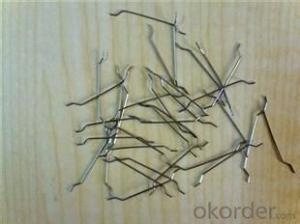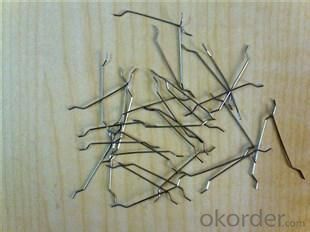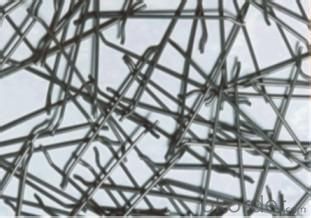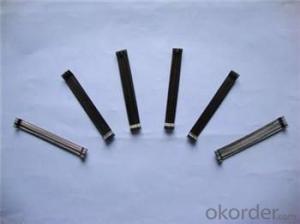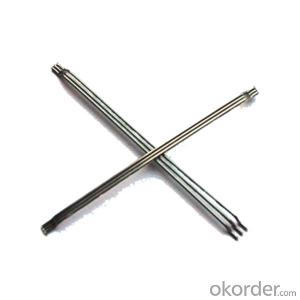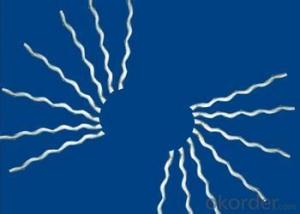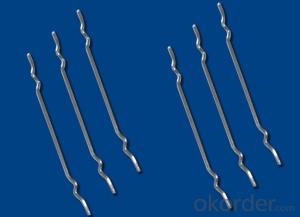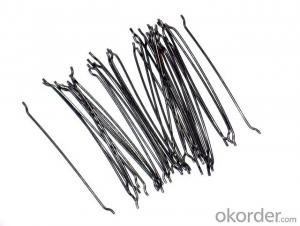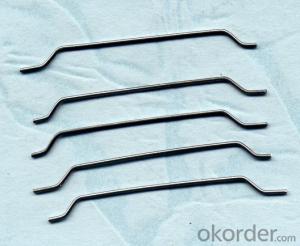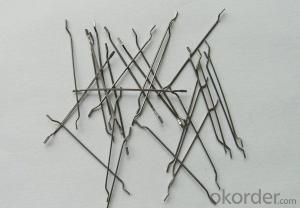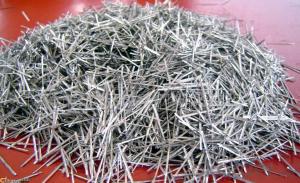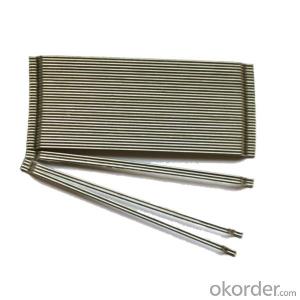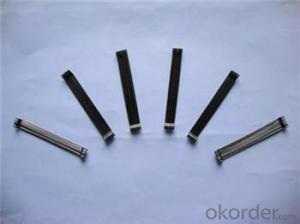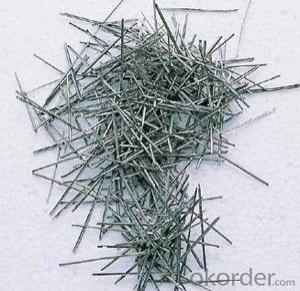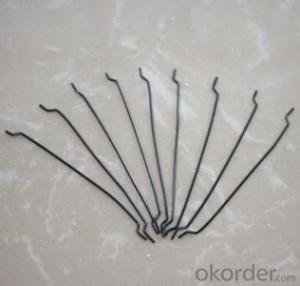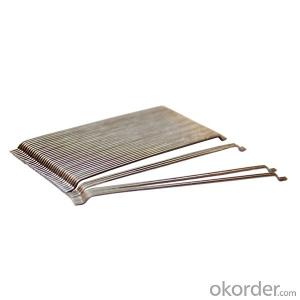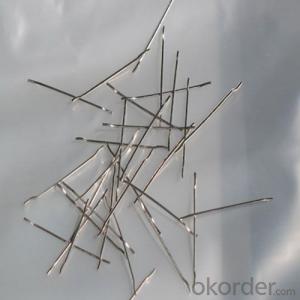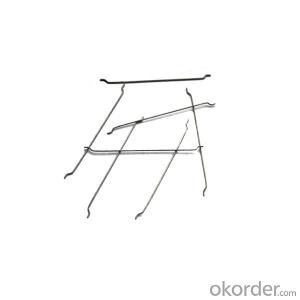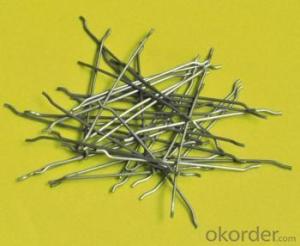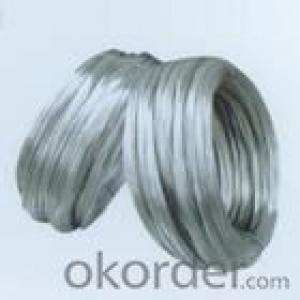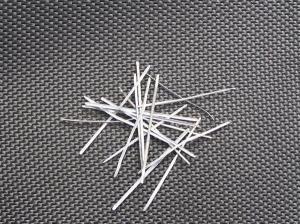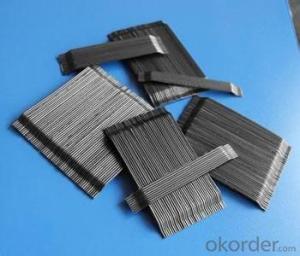Melt Extract Stainless Steel Fiber Construction Materials Price List Bulk Buy from China Steel Fiber
- Loading Port:
- Tianjin
- Payment Terms:
- TT OR LC
- Min Order Qty:
- 1 m.t.
- Supply Capability:
- 10000 m.t./month
OKorder Service Pledge
Quality Product, Order Online Tracking, Timely Delivery
OKorder Financial Service
Credit Rating, Credit Services, Credit Purchasing
You Might Also Like
Quick Details
Place of Origin: Tianjin, China (Mainland)
Model Number: 0.55
Material: Steel
Production Process: Cold drawn
Fiber Lengh: 35
Type: 1
Compressive Strength: >1200MPa
Aspect ratio: 63
Standard: ASTM A820M-11
Section Shape: Circular
Application: Concrete Reinforcement
Product Application: Industrial Floor
Packaging & Delivery
| Packaging Details: | 20 kg/Bag,50 bags/Pallet or 1,000kg/ Bulk Bag |
|---|---|
| Delivery Detail: | 1 Month |
Product Description
| Diameter | 0.55 mm (0.217 in) | ||
| Length | 35 mm (13.780 in) | ||
| Aspect Ratio | 63 | ||
| Tensile strength | 1200 MPa | ||
| Type | Cold drawn Steel Fiber | ||
| End | Hooked-end Steel Fiber | ||
| Glued/Loose | Glued Steel Fiber | ||
| Bending Angle | 45°(min.30°) | ||
| Usage & Performance | Floor:Trafficked areas and Industrial floors | ||
| Shotcrete :Slope stabilization and Final lining | |||
| Precast concrete:Pipe and Railway sleepers | |||
| Packing | Standard Export Pallet Packing | Bag Packing | 20 kg/Bag,50 bags/Pallet |
| Bulk Packing | 1,000kg/ Bulk Bag | ||
| Loading Quantity | 20’GP | 20-25 Tonne/Tonnes | |
| 40’GP | 25-27 Tonne/Tonnes | ||
| 40’HQ | 25-27 Tonne/Tonnes | ||
| MOQ | 1 kg for trial order | ||
| Supply Ability | 10,000 Tonne/Tonnes per Year | ||
| Payment Terms | T/T or L/C at sight | ||
| Delivery Time | Within 15 days after receiving deposit or original L/C at sight | ||
| Certification | ISO9001:2000, CE, | ||
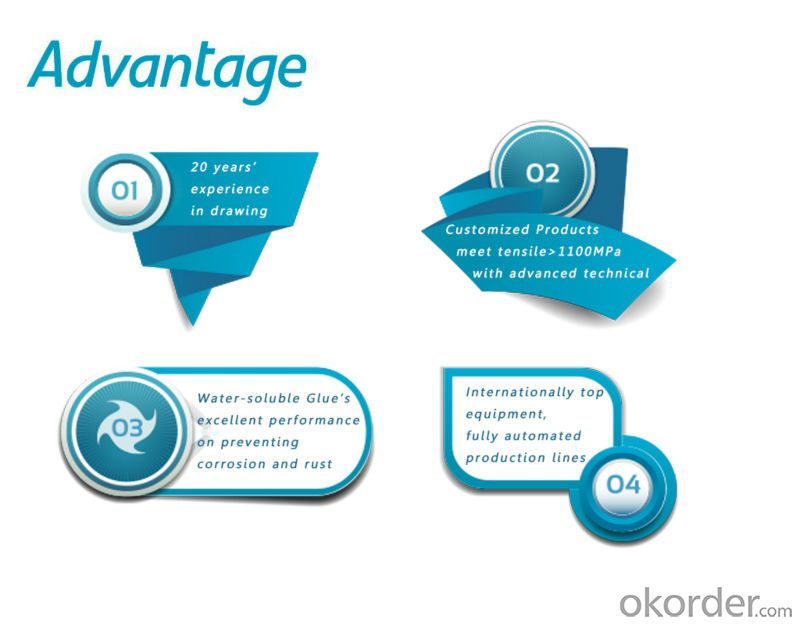
| Product | Diameter | Length mm/in | Aspect Ratio | Type | Packing |
| G-6030 | 0.5 mm (0.197 in) | 30 mm (11.811 in) | 60 | Glued | 20 kg/Bag, or 1,000kg/ Bulk Bag |
| G-6535 | 0.55 mm (0.217 in) | 35 mm (13.780 in) | 65 | Glued | 20 kg/Bag, or 1,000kg/ Bulk Bag |
| G-6035 | 0.6 mm (0.236 in) | 35 mm (13.780 in) | 60 | Glued | 20 kg/Bag, or 1,000kg/ Bulk Bag |
| G-8060 | 0.75 mm (0.295 in) | 60 mm (23.622 in) | 80 | Glued | 20 kg/Bag, 50 bags/Pallet |
| G-6060 | 0.9 mm (0.354 in) | 60 mm (23.622 in) | 60 | Glued | 20 kg/Bag, 50 bags/Pallet |
| G-6030 | 0.5 mm (0.197 in) | 30 mm (11.811 in) | 60 | Loose | 20 kg/Bag, or 1,000kg/ Bulk Bag |
| G-6535 | 0.55 mm (0.217 in) | 35 mm (13.780 in) | 65 | Loose | 20 kg/Bag, or 1,000kg/ Bulk Bag |
| G-6035 | 0.6 mm (0.236 in) | 35 mm (13.780 in) | 60 | Loose | 20 kg/Bag, or 1,000kg/ Bulk Bag |
| G-8060 | 0.75 mm (0.295 in) | 60 mm (23.622 in) | 80 | Loose | 20 kg/Bag, 50 bags/Pallet |
| G-6060 | 0.9 mm (0.354 in) | 60 mm (23.622 in) | 60 | Loose | 20 kg/Bag, 50 bags/Pallet |
- Q: Can melt extract stainless steel fiber be used in retaining wall construction?
- Yes, melt extract stainless steel fiber can be used in retaining wall construction. These fibers are highly durable and have excellent tensile strength, making them ideal for reinforcing concrete structures such as retaining walls. The stainless steel fibers are typically added to the concrete mixture during the mixing process, providing reinforcement throughout the entire structure. This helps to increase the overall strength and durability of the retaining wall, making it more resistant to cracking and shifting. Additionally, the corrosion resistance of stainless steel fibers ensures that the retaining wall will maintain its structural integrity over time, even in harsh environmental conditions. Overall, using melt extract stainless steel fiber in retaining wall construction is a reliable and effective method for enhancing the strength and durability of the structure.
- Q: How does melt extract stainless steel fiber improve the resistance to carbonation in concrete?
- The durability of concrete against carbonation is enhanced by the incorporation of melt extract stainless steel fiber, which provides improved resistance and protection. These stainless steel fibers act as reinforcement when added to the concrete mixture, increasing overall strength and resistance to various factors that cause deterioration, including carbonation. Carbonation is a chemical process that occurs when carbon dioxide (CO2) from the atmosphere reacts with the calcium hydroxide (Ca(OH)2) present in the concrete, resulting in the formation of calcium carbonate (CaCO3). This reaction reduces the alkalinity of the concrete and weakens its protective layer, making it susceptible to potential corrosion of the reinforcing steel. The addition of melt extract stainless steel fiber significantly improves the resistance to carbonation in concrete. These fibers create a three-dimensional network within the concrete matrix, enhancing its mechanical properties and reducing the formation of cracks. This network also acts as a barrier, limiting the contact between atmospheric carbon dioxide and calcium hydroxide, thus preventing carbonation. Moreover, the stainless steel fibers help maintain the alkalinity of the concrete by reducing the penetration of carbon dioxide. They also provide an electrochemical protection mechanism by acting as cathodic sites, preventing the corrosion of the reinforcing steel. This cathodic protection is achieved through the formation of a passive oxide layer on the surface of the stainless steel fibers, which resists corrosion and inhibits the carbonation process. Overall, the addition of melt extract stainless steel fiber to concrete enhances its resistance to carbonation by increasing its strength, reducing crack formation, limiting the ingress of CO2, maintaining alkalinity, and providing cathodic protection against corrosion. This results in a more durable and long-lasting concrete structure with improved resistance to carbonation-induced deterioration.
- Q: Does melt extract stainless steel fiber improve the resistance to impact of shotcrete?
- Indeed, the incorporation of melt extract stainless steel fiber in shotcrete does indeed enhance its resistance to impact. Shotcrete, a technique involving the high-velocity spraying of concrete onto a surface, benefits from the inclusion of stainless steel fiber, which serves to fortify its impact resistance. Acting as reinforcement within the shotcrete, these stainless steel fibers bolster its durability and capacity to withstand forces of impact. By absorbing and dispersing the energy arising from impacts, these fibers decrease the likelihood of cracks, spalling, and other forms of damage. Moreover, the stainless steel fibers augment the shotcrete's tensile strength, rendering it more resistant to cracking and elevating its overall structural integrity. Undoubtedly, the addition of melt extract stainless steel fiber to shotcrete yields a significant enhancement in its resistance to impact, establishing it as the preferred choice for applications where impact resistance is paramount, such as tunnels, bridge decks, and retaining walls.
- Q: Can melt extract stainless steel fiber be used in shotcrete tunnel boring machine applications?
- Yes, melt extract stainless steel fiber can be used in shotcrete tunnel boring machine applications. Shotcrete is a method of applying concrete or mortar using a high-pressure hose, and the addition of stainless steel fiber can enhance the mechanical properties and durability of the shotcrete. The melt extract stainless steel fiber is made from stainless steel through a melting and extraction process, resulting in a high-strength fiber with excellent corrosion resistance. These properties make it suitable for use in tunnel boring machine applications where the shotcrete needs to withstand high pressures, vibrations, and potential exposure to moisture or chemicals. Additionally, the stainless steel fiber can improve the flexural and tensile strength of the shotcrete, reducing the risk of cracking and enhancing the overall stability and performance of the tunnel structure.
- Q: What is the recommended fiber content when using melt extract stainless steel fiber in concrete?
- The recommended fiber content when using melt extract stainless steel fiber in concrete is typically around 1-2% by volume.
- Q: Can melt extract stainless steel fiber be used in lightweight concrete?
- Yes, melt extract stainless steel fiber can be used in lightweight concrete. Stainless steel fiber is added to concrete to enhance its mechanical properties, such as improving its tensile strength, flexural strength, and impact resistance. Lightweight concrete, on the other hand, is a type of concrete that incorporates lightweight aggregates or foaming agents to reduce its density and improve its thermal and acoustic properties. By adding melt extract stainless steel fiber to lightweight concrete, it can provide additional reinforcement and enhance its performance. The stainless steel fibers help to distribute the stresses more evenly throughout the concrete matrix, making it more resistant to cracking and improving its overall durability. Additionally, the use of stainless steel fibers can also increase the ductility of lightweight concrete, allowing it to better withstand dynamic loads and reduce the risk of sudden failure. In conclusion, melt extract stainless steel fiber is a suitable option for reinforcing lightweight concrete, as it can improve its mechanical properties and enhance its durability.
- Q: Can melt extract stainless steel fiber be used in the construction of dams?
- Melt extract stainless steel fibers are applicable for dam construction. They possess high tensile strength, corrosion resistance, and durability, making them suitable for various construction purposes. These fibers can be incorporated into the concrete mixture during dam construction to enhance its mechanical properties, prevent cracking, and reduce shrinkage. By reinforcing the concrete, they improve the overall strength and lifespan of the dam, making it capable of withstanding water pressure and environmental conditions. Moreover, these stainless steel fibers offer superior resistance against chemical attacks, which is crucial in dam projects where exposure to water and chemicals is common. In conclusion, the utilization of melt extract stainless steel fibers in dam construction helps maintain the dam's structural integrity and long-term performance.
- Q: The steel fiber concrete cover per cubic concrete how much steel fiber
- After buying the equipment, they provided us with a recipe ratio.
- Q: Can melt extract stainless steel fiber be used in self-compacting concrete (SCC)?
- Yes, melt extract stainless steel fiber can be used in self-compacting concrete (SCC).
- Q: Can melt extract stainless steel fiber be used in fiber-reinforced shotcrete?
- Fiber-reinforced shotcrete can indeed incorporate melt extract stainless steel fiber. Shotcrete applications commonly utilize stainless steel fibers due to their impressive tensile strength, resistance to corrosion, and overall durability. The melt extract process guarantees consistent and uniform fiber properties, rendering it an ideal choice for reinforcing shotcrete. The inclusion of stainless steel fibers in shotcrete greatly enhances its mechanical properties, including flexural and impact strength, crack resistance, and ductility. As a result, the overall performance and lifespan of the shotcrete structure are significantly improved. However, it is crucial to consider the specific requirements of the application, fiber dosage, and mix design to ensure the appropriate and effective utilization of stainless steel fibers in fiber-reinforced shotcrete.
Send your message to us
Melt Extract Stainless Steel Fiber Construction Materials Price List Bulk Buy from China Steel Fiber
- Loading Port:
- Tianjin
- Payment Terms:
- TT OR LC
- Min Order Qty:
- 1 m.t.
- Supply Capability:
- 10000 m.t./month
OKorder Service Pledge
Quality Product, Order Online Tracking, Timely Delivery
OKorder Financial Service
Credit Rating, Credit Services, Credit Purchasing
Similar products
Hot products
Hot Searches
Related keywords
